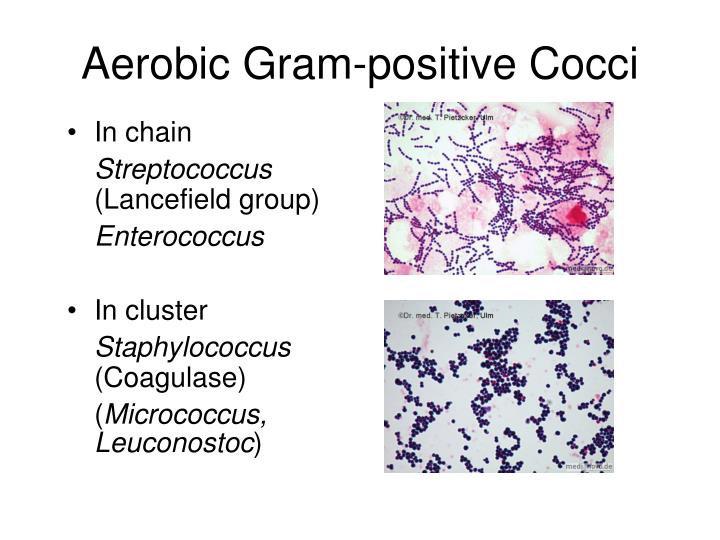

- #GRAM POSITIVE COCCI IN CLUSTERS SERIAL#
- #GRAM POSITIVE COCCI IN CLUSTERS SKIN#
- #GRAM POSITIVE COCCI IN CLUSTERS PRO#
Serum procalcitonin levels as a diagnostic marker for septic arthritis: A meta-analysis. Zhao J, Zhang S, Zhang L, Dong X, Li J, Wang Y, et al. Bacterial Nosocomial Infections: Multidrug Resistance as a Trigger for the Development of Novel Antimicrobials. Sousa SA, Feliciano JR, Pita T, Soeiro CF, Mendes BL, Alves LG, et al.
#GRAM POSITIVE COCCI IN CLUSTERS SKIN#
Laboratory diagnosis of bone, joint, soft-tissue, and skin infections. Centers for Disease Control and Prevention. Sexually transmitted diseases treatment guidelines 2006. 14(5):558-65.Ĭenters for Disease Control and Prevention Workowski KA, Berman SM. Delayed treatment of septic arthritis in the neonate: A review of 52 cases. Li Y, Zhou Q, Liu Y, Chen W, Li J, Yuan Z, et al. Shortening the Time of the Identification and Antimicrobial Susceptibility Testing on Positive Blood Cultures with MALDI-TOF MS. Tsai YW, Lin TC, Chou HY, Hung HY, Tan CK, Wu LC, et al. Does this adult patient have septic arthritis?. Margaretten ME, Kohlwes J, Moore D, Bent S.
#GRAM POSITIVE COCCI IN CLUSTERS SERIAL#
There is growing interest in the usefulness of C-reactive protein (CRP) in documenting a therapeutic response to empirically prescribed antimicrobial through serial measurements. This test appears to be more useful in ruling in than in excluding the diagnosis of septic arthritis because the specificity of PCT is quite low.

In these cases, measurement of serum procalcitonin (PCT) should be considered. Gram stain negative or unavailableĭiagnosis of the septic joint is particularly challenging in patients with underlying inflammatory disease, such as rheumatoid arthritis or SLE, and a negative Gram stain. For further discussion please refer to Medscape reference article Septic Arthritis. The author would advocate use of linezolid or daptomycin instead. The usefulness of vancomycin is being challenged for several reasons: 1) the ability to acheive theraputic levels (peak level 25-40mcg/ml and trough levels (5-12mcg/ml ) may be extremely difficult to acheive in the seriously ill patient with fluctuating renal function and 2) the prevalence of resistance of Gram-positive cocci to it has increased. In addition, there has been a marked increase in MRSA infections and resistant P aeruginosa. This overuse may rise from the unfamiliarity with the proper use of antibiotics in the febrile individual with COVID. There has been a significant increase in the use of antibiotics in both community and inpatient settings. Patients have avoided seeking treatment of a variety of diseases out of fear of contracting the viruse from a variety of health care settings. The COVID-19 pandemic has triggered secondary pandemics such as a significant increase in opioid abuse and its various infectious complications, in part due to the effects of social isolation. Newer methods, such as the Maldi-Tof technique, when combined with the Phoenix M50 system, have considerably shortened the turnaround time of organism identification (from 48 to 28 hrs) and antibiotic sensitivity results (from 72 to 50.3 hrs). Results of antibiotic sensitivity testing require at least 72 more hours. Most commonly encountered pathogens of SA may take up to 1 to 2 days to grow out and be identified on solid media. The Gram stain is positive in less than 50% of cases.

#GRAM POSITIVE COCCI IN CLUSTERS PRO#
In this situation, measurement of pro calcitonin and CRP may be helpful. If the Gram stain is negative and there are no crystals apparent, it may be reasonable to withhold antibiotics and treat for a crystalline arthritis, unless there is a significant potential source of bacteremia such as a urinary tract infection. Examination of the joint fluid typically shows marked leukocytosis often greater than 50,000/ML low glucose levels and lack of crystals. The sensitivity of the Gram stain ranges from 30-50%. Empiric antibiotic therapy of septic arthritis of native joints(SA) has been guided primarily by the findings of the Gram staining of synovial fluid.


 0 kommentar(er)
0 kommentar(er)
